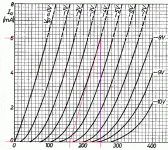I am trying to calculate the ra for a triode strapped EF86 for a parafeed linestage. My OPTs are 15K:500, so I am hoping this will work -- several NOS Amperexes just dropped into my lap, so it seems like a good place to use them.
Anyhow,
Here is a EF86 datasheet: http://www.mif.pg.gda.pl/homepages/frank/sheets/030/e/EF86.pdf
Triode strapped, mu is about 25. It looks to me like gm is .004 which would put ra at 12500. Does this seem right?
Anyhow,
Here is a EF86 datasheet: http://www.mif.pg.gda.pl/homepages/frank/sheets/030/e/EF86.pdf
Triode strapped, mu is about 25. It looks to me like gm is .004 which would put ra at 12500. Does this seem right?
You would need to specify your operting conditions for a more acurate answer...Since these a VARIABLES...not constants...
For example: At 150v at the plate, -3V bias with 2 mA of DC current.... Your Plate resistance would be 18.75k ohms....
mu would be roughly 34....
The gm would be roughly 1.8 mA/v ....
Chris
For example: At 150v at the plate, -3V bias with 2 mA of DC current.... Your Plate resistance would be 18.75k ohms....
mu would be roughly 34....
The gm would be roughly 1.8 mA/v ....
Chris
Hmmm. The triode curves look like with 150V on the plate, changing Vg from -3 to -2 results in a change in Ia from 2mA to 4.2mA. mu does look to be higher than I though (using a CCS on the plate ~ 37), so other than some sloppy chart reading, I am at least doing the calculation correctly. This leads to ra = 17K or so.
Anyone care to venture an opinion on whether 15K:500 parafeed transformers will work here, or if using them at 30K:1K is a good idea ... or should I just use my usual answer at times like this which is to use the 5842 wunder-tube ...
Anyone care to venture an opinion on whether 15K:500 parafeed transformers will work here, or if using them at 30K:1K is a good idea ... or should I just use my usual answer at times like this which is to use the 5842 wunder-tube ...
dsavitsk, the plate resistance at any operating point is the slope of the plate curve there. (Really, it's the inverse of the slope: ra = dV/dI) I've draw a line that is tangent to the -4V line at roughly 225V@5mA. The slope of the line is the (change in voltage) / (change in current) = (250V-160V)/6mA = 15k
-- Dave
-- Dave
Attachments
Anyone care to venture an opinion on whether 15K:500 parafeed transformers will work here, or if using them at 30K:1K is a good idea ... or should I just use my usual answer at times like this which is to use the 5842 wunder-tube
Use the 5842. Experience says 3X Rp is in order for the load. Don't forget that primary inductance is important.
Eli Duttman said:Use the 5842. Experience says 3X Rp is in order for the load. Don't forget that primary inductance is important.
This brings up a question, and my guess is that the actual answer is a lot denser than I am thinking. But, since it is parafeed, isn't the load the CCS plate load, which has an impedance in the Mohms range? So, how does the transformer's primary interact?
There is a tool for working through some of this at http://www.siteswithstyle.com/voltsecond/Parafeed_fun/Parafeed_fun.html so maybe grinding through the math is the answer here.
But, since it is parafeed, isn't the load the CCS plate load, which has an impedance in the Mohms range? So, how does the transformer's primary interact?
The load the tube "sees" is the parallel combination of the CCS and the load presented by the trafo. Obviously, the trafo is dominant.
Inductive reactance (Xl) = 2 pi F L
If the primary's inductance is too small, LF info. has a low impedance path around the load reflected from the secondary.
- Status
- This old topic is closed. If you want to reopen this topic, contact a moderator using the "Report Post" button.
- Home
- Amplifiers
- Tubes / Valves
- EF86 Gm
